Aldwell-Schachter Chapter 9
Click on a musical example for playback
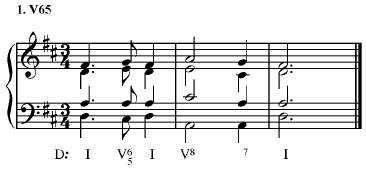
V6/5 as lower neighbor to I. Note that here the lower neighbor figure is being recapitulated in the other voices as either a common tone (tenor) or as upper neighbor tones in the upper voices. That doesn't make anything all that interesting, but it does serve its purpose quite well as an expansion of I.
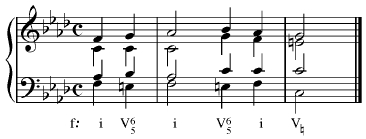
V6/5 remains the lower neighbor in this example, but the soprano is moving in scale steps rather than in neighbor -tone motion. Note that on the downbeat of measure 2 the 3rd of the tonic triad has been doubled: the B-flat in the tenor at the end of measure 1 must resolve to A-flat. Why?
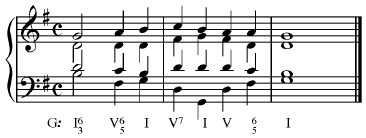
V6/5 as incomplete lower neighbor, prepared by I6 instead of by I. The soprano in this passage, ascending ^1-^2-^3, is probably the most common soprano figured encountered with such a progression, but it is of course not the only one. The progression also demonstrates the use of V6/5 as a substitute for V6, in which it is being used to expand the dominant in an identical manner to V6. Note the doubling of the third of I in measure 1.
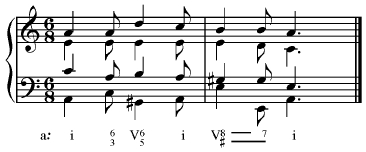
V6/5 with incomplete neighbors (upper in the soprano, lower in the bass), in both voices. This is not only allowed, but quite effective. Note the voice exchange in the movement from i to i6.
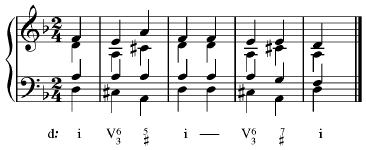
V6/5's resolution would normally be a strictly-required movement to I, given that the leading tone is in the bass and forms a tritone with ^4 (which is the seventh of the chord). However, V6/5 can form part of an expansion, moving to a V7. (V6/5 can never move to V, however, since the seventh of the chord is then lost and never resolved.)
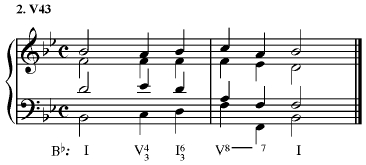
V4/3 is here encountered in a situation where vii6 could be just as easily encountered. Note that V4/3 has one distinct advantage to vii6: the voice leading is overall smoother, less awkward. The presence of a common tone between I-V4/3-I6 allows for the improved voice leading. However, V4/3 is a more "noticeable" chord than vii6; it is not quasi-rootless like a diminished triad, but is a full-bodied dominant seventh chord.
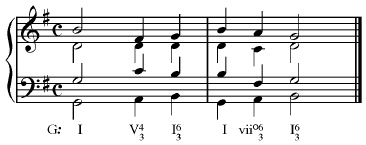
Although V4/3 may be used in many situations where vii6 is encountered, it cannot be used in absolutely every situation. In this example, the first measure contains a vii6-like use of V4/3, approached via an incomplete neighbor in the soprano. The second measure contains a vii6 in a position at which a V4/3 simply could not be used in a four-voice texture. Why not?
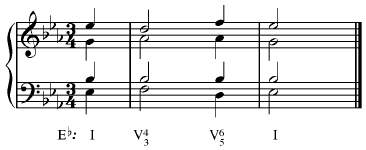
As a full-fledged V7, V4/3 can do things that vii6 simply cannot. Here, V4/3 is used to expand a V7, by moving to a V6/5—thus creating a double neighbor tone to I.
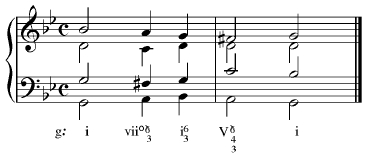
V4/3, as a full-fledged V7, can act cadentially. There are two things to point out here: 1) vii6 can actually be used in similar circumstances, and 2) whether V4/3 or vii6 is used, this is a very weak, unconvincing kind of cadence. This doesn't mean that it is to be shunned—it simply means that it should not be used as a final cadence.
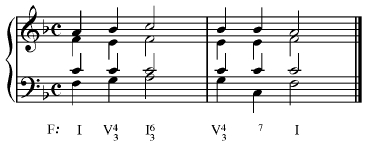
A few remarks about this one. First, notice that the B-flat in the first measure soprano is the 7th of the seventh chord, and yet it is resolving upwards rather than downwards. This passage is so similar to a passage that would use a vii6, and the soprano note is so clearly of a passing nature on its way to the C, that the ear is not particularly bothered. Second, measure 2 demonstrates V4/3 expanding V7.
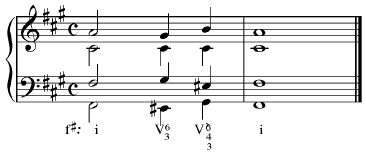
Just in case you thought that V4/3 was used in expansions as only the first chord that led to a V6/5 or V7, here it is as the second chord in an expansion of V6/5. Note that it is the 6th of the V4/3 which is raised in minor. Therefore, when analyzing in minor, the arabic numeral '6' should be written with a slash, indicating that it is raised.
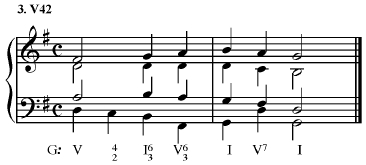
V4/2 can be best understood by this example, which shows it in a characteristic role of providing a link between V and I6/3. The bass line moves downwards by step, creating the 7th of the V7 in the bass. Because the 7th of the V7 is in the bass, it must resolve downwards to ^3—and I6/3 is the only chord we know right now whose bass note is ^3. Even though there are alternate chords, I6/3 will remain the primary goal of a V4/2.
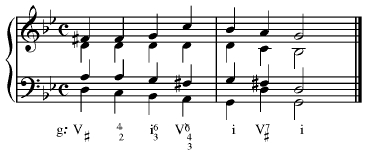
Similar to the above example. The difference here is in minor. Note that it is the 4th of V4/2 which is raised. The most common sign for raising the 4th scale degree is the plus sign—again one of those "convention" issues, and not a matter of absolute right and wrong.
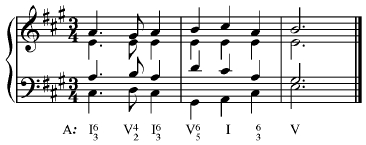
Another typical usage of V4/2: as an expansion of I6/3. It supports quite nicely an upper neighbor tone in the bass, complemented in this example by a lower neighbor tone in the soprano. Note that the alto is another one of those thrilling melodic lines so typical of these early exercises.
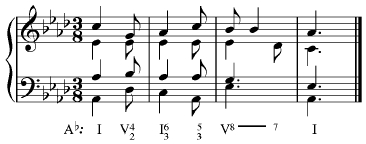
V4/2 approached as an incomplete upper neighbor. Note that it is set with an incomplete lower neighbor in the soprano—matching tit for tat, as it were.
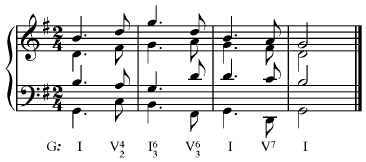
This example shows that V4/2 does not have to be set with the soprano complementing the bass: here an incomplete neighbor in the bass sets a triadically leaping soprano.